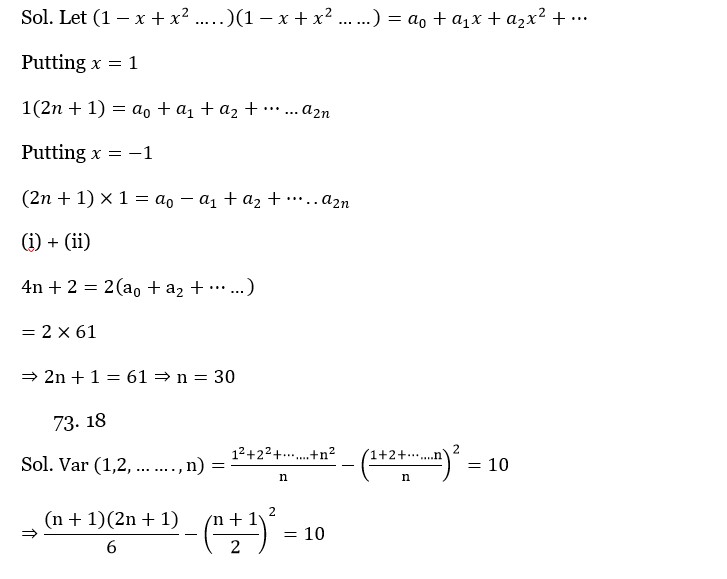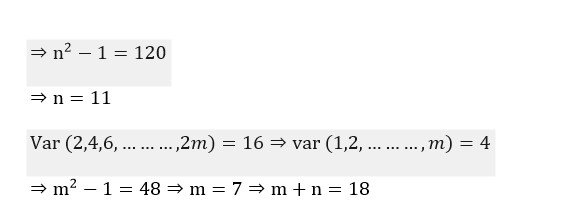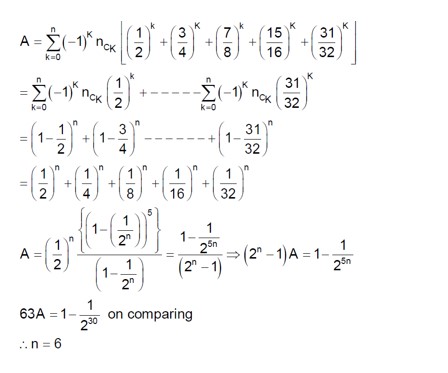Maths Binomial Theorem
Get insights from 93 questions on Maths Binomial Theorem, answered by students, alumni, and experts. You may also ask and answer any question you like about Maths Binomial Theorem
Follow Ask QuestionQuestions
Discussions
Active Users
Followers
New answer posted
2 months agoContributor-Level 10
Expression = (49)¹²? - 1) / 48
This uses the sum of a geometric series or a? - b? factorization.
(x? - 1) / (x - 1) = 1 + x + x² + . + x? ¹.
Let x = 49. (49¹²? - 1)/48 is an integer.
The solution shows (49? ³-1) (49? ³+1) / 48. This is correct factorization. Since 49 is odd, 49? ³ is odd. So 49? ³-1 and 49? ³+1 are consecutive even numbers. One is divisible by 2, the other by 4, so their product is divisible by 8. Also, 49 ≡ 1 (mod 3), so 49? ³-1 is divisible by 3. Hence the numerator is divisible by 24. It is also divisible by 48.
New answer posted
2 months agoContributor-Level 9
(1 - x + x²)³? = ∑ a? x? (from j=0 to 3n)
= a? + a? x + a? x² + . + a? x³? (I)
Let A = a? + a? + a? + .
Let B = a? + a? + a? + .
In (I) put x = 1: (1 - 1 + 1)³? = 1.
1 = a? + a? + a? + a? + . (A + B = 1)
In (I) put x = -1: (1 - (-1) + (-1)²)³? = 3³?
3³? = a? - a? + a? - a? + . (A - B = 3³? )
(This seems incorrect based on the provided solution. Following the image:)
In (I) put x = -1, (1+1+1)^n = 1. (There must be a typo in the original problem, probably (1-x+x²)^n).
Assuming (1-x+x²)^n. Put x=-1 gives 3^n.
The provided text says putting x=-1 gives 1.
1 = a? - a? + a? - a? + .
Adding the two equations: 2 = 2 (a? + a? + a? + .) = 2A
New answer posted
2 months agoContributor-Level 9
(3¹/? + 5¹/? )?
General term =? C? (3¹/? )? (5¹/? )? =? C? 3^ (60-r)/4) 5^ (r/8)
Terms are rational for r being a multiple of 8 and (60-r) being a multiple of 4.
If r is a multiple of 8, then 60-r is 60 - 8k. Since 60 is a multiple of 4, 60-8k is also a multiple of 4.
So, we just need r to be a multiple of 8.
r = 0, 8, 16, 24, 32, 40, 48, 56. (Total 8 rational terms)
Total terms are 61.
Number of irrational terms = 61 - 8 = 53 = n.
∴ n - 1 = 52.
New answer posted
2 months agoContributor-Level 10
The expression to be simplified is (x^ (1/3) - x^ (-1/2)¹? based on the method shown in the OCR.
We need the term independent of x in its binomial expansion.
The general term (T? ) is ¹? C? (x^ (1/3)¹? (-x^ (-1/2)?
The power of x is (10-r)/3 - r/2.
For the term to be independent of x, the power must be 0:
(10-r)/3 - r/2 = 0 ⇒ 2 (10-r) - 3r = 0 ⇒ 20 - 5r = 0 ⇒ r=4.
The coefficient is ¹? C? * (-1)? = ¹? C?
¹? C? = (10*9*8*7)/ (4*3*2*1) = 10 * 3 * 7 = 210.
New answer posted
2 months agoContributor-Level 10
The problem asks to evaluate S = ∑ (k=0 to 10) (k² + 3k) ¹? C? (Assuming typo in OCR is k²).
S = ∑k² ¹? C? + 3∑k ¹? C?
Using the identities ∑k? C? = n 2? ¹ and ∑k²? C? = n (n+1)2? ².
For n=10:
3∑k ¹? C? = 3 * 10 * 2? = 30 * 2?
∑k² ¹? C? = 10 (11)2? = 110 * 2?
S = 110 * 2? + 30 * 2? = 110 * 2? + 60 * 2? = 170 * 2? = 85 * 2?
The OCR seems to follow a different path with typos, but arrives at 19 * 2¹?
Let's follow the OCR's result: 19 * 2¹? = α * 3¹? + β * 2¹?
Comparing coefficients, we get α = 0 and β = 19.
α + β = 0 + 19 = 19.
New answer posted
2 months agoContributor-Level 10
Limit (θ→0) [tan(πcos²θ) / sin(2πsin²θ)]
Let θ → 0. Then cos²θ → 1 and sin²θ → 0.
Let u = πsin²θ. As θ → 0, u → 0.
cos²θ = 1 - sin²θ = 1 - u/π.
The expression becomes:
Limit (u→0) [tan(π(1 - u/π)) / sin(2u)]
= Limit (u→0) [tan(π - u) / sin(2u)]
= Limit (u→0) [-tan(u) / sin(2u)]
= Limit (u→0) [-tan(u) / (2sin(u)cos(u))]
= Limit (u→0) [-(sin(u)/cos(u)) / (2sin(u)cos(u))]
= Limit (u→0) [-1 / (2cos²(u))] = -1 / (2 * 1²) = -1/2.
New answer posted
2 months agoContributor-Level 10
Given the equation y = 3 + 1/ (4 + 1/y).
y - 3 = 1 / (4y+1)/y)
y - 3 = y / (4y+1)
(y-3) (4y+1) = y
4y² + y - 12y - 3 = y
4y² - 11y - 3 = y
4y² - 12y - 3 = 0
Using the quadratic formula to solve for y:
y = [-b ± √ (b²-4ac)] / 2a
y = [12 ± √ (-12)² - 4*4* (-3)] / (2*4)
y = [12 ± √ (144 + 48)] / 8
y = [12 ± √192] / 8 = [12 ± 8√3] / 8 = 3/2 ± √3.
y = 1.5 ± √3.
Since y > 0 (from the structure of the equation), both solutions are positive. The solution selects y = 1.5 + √3.
New answer posted
2 months agoContributor-Level 10
The expansion is (x + x^ (log? x)?
The (r+1)-th term is T? =? C? * x? * (x^ (log? x)?
The 4th term means r=3.
T? =? C? * x? * (x^ (log? x)³ = 35 * x? * x^ (3 log? x) = 35 * x^ (4 + 3 log? x).
Given T? = 4480.
35 * x^ (4 + 3 log? x) = 4480
x^ (4 + 3 log? x) = 4480 / 35 = 128.
x^ (4 + 3 log? x) = 128.
Take log? on both sides:
log? (x^ (4 + 3 log? x) = log? (128)
(4 + 3 log? x) * (log? x) = 7
Let t = log? x.
(4 + 3t)t = 7
3t² + 4t - 7 = 0
3t² - 3t + 7t - 7 = 0
3t (t-1) + 7 (t-1) = 0
(3t+7) (t-1) = 0
t = 1 or t = -7/3.
log? x = 1 ⇒ x = 2¹ = 2.
log? x = -7/3 ⇒ x = 2^ (-7/3).
Since x ∈ N, x = 2.
Taking an Exam? Selecting a College?
Get authentic answers from experts, students and alumni that you won't find anywhere else
Sign Up on ShikshaOn Shiksha, get access to
- 65k Colleges
- 1.2k Exams
- 679k Reviews
- 1800k Answers



